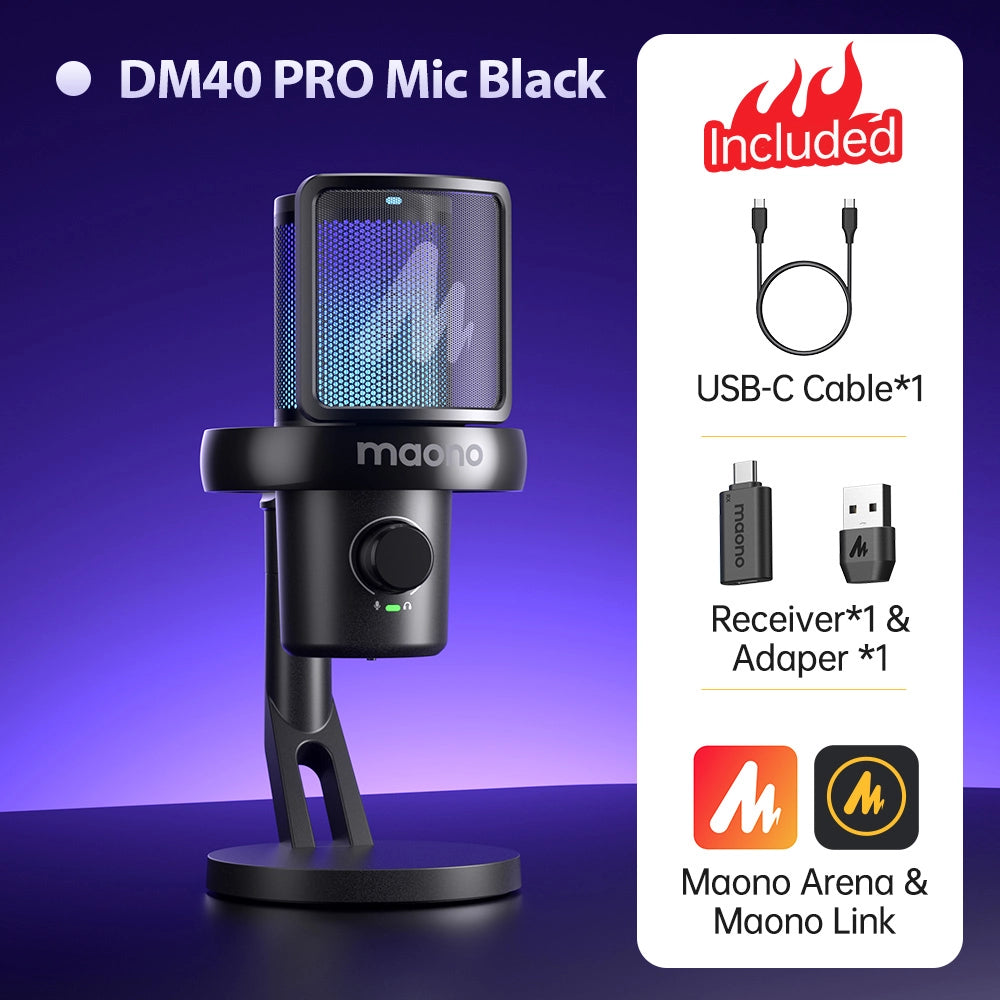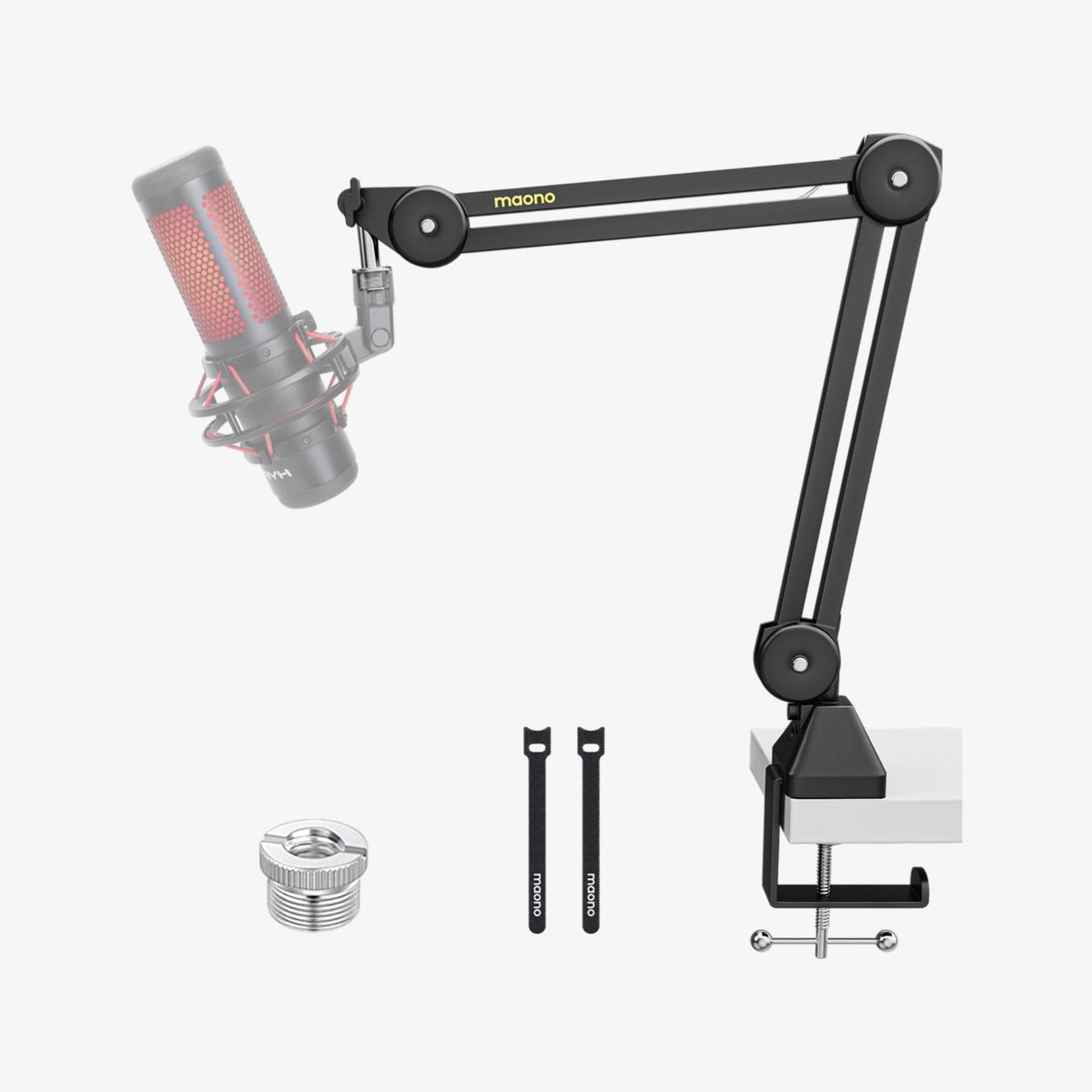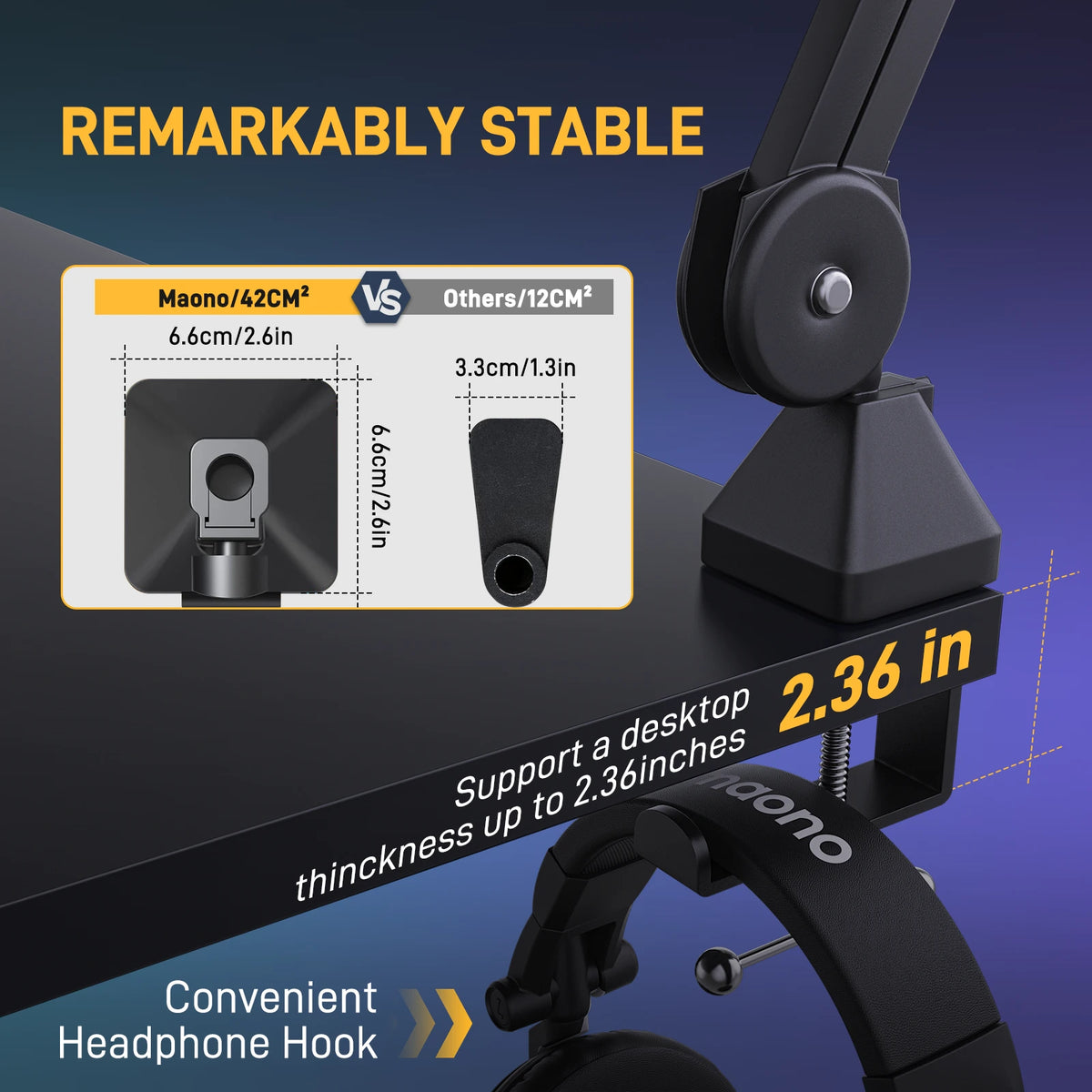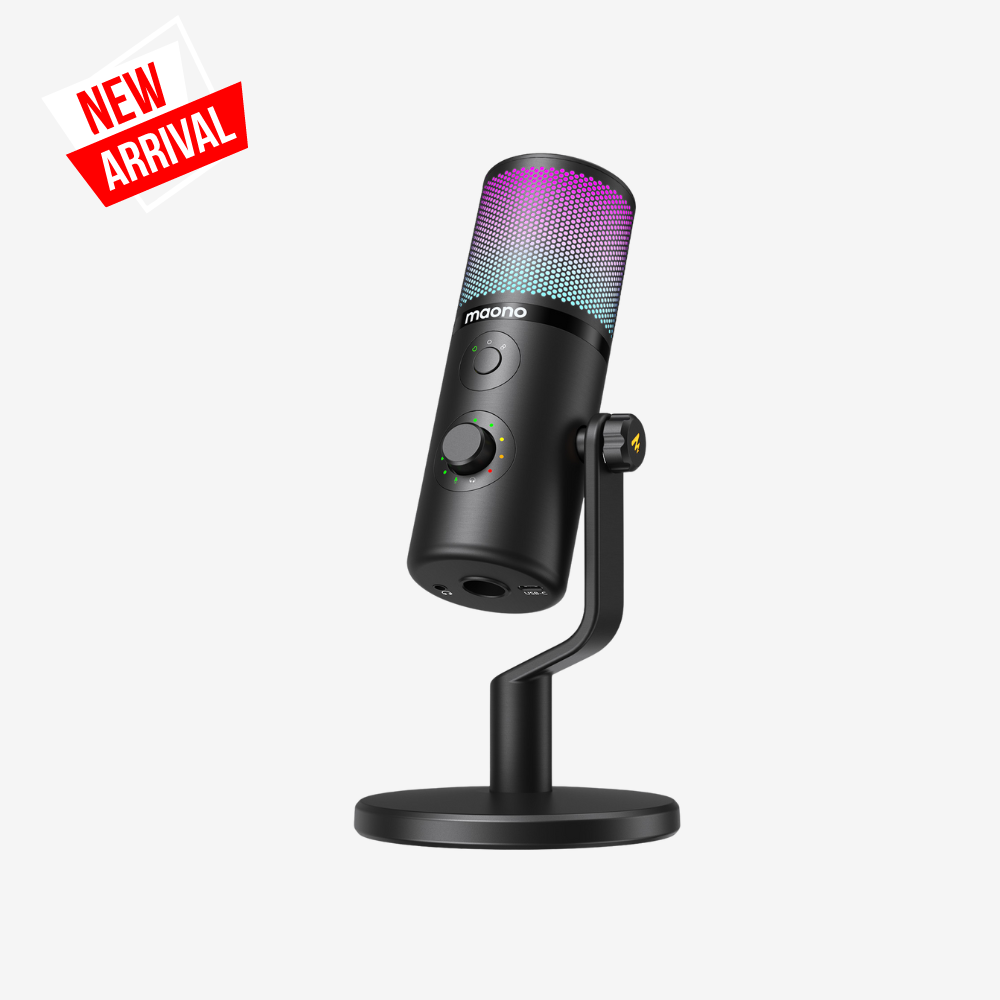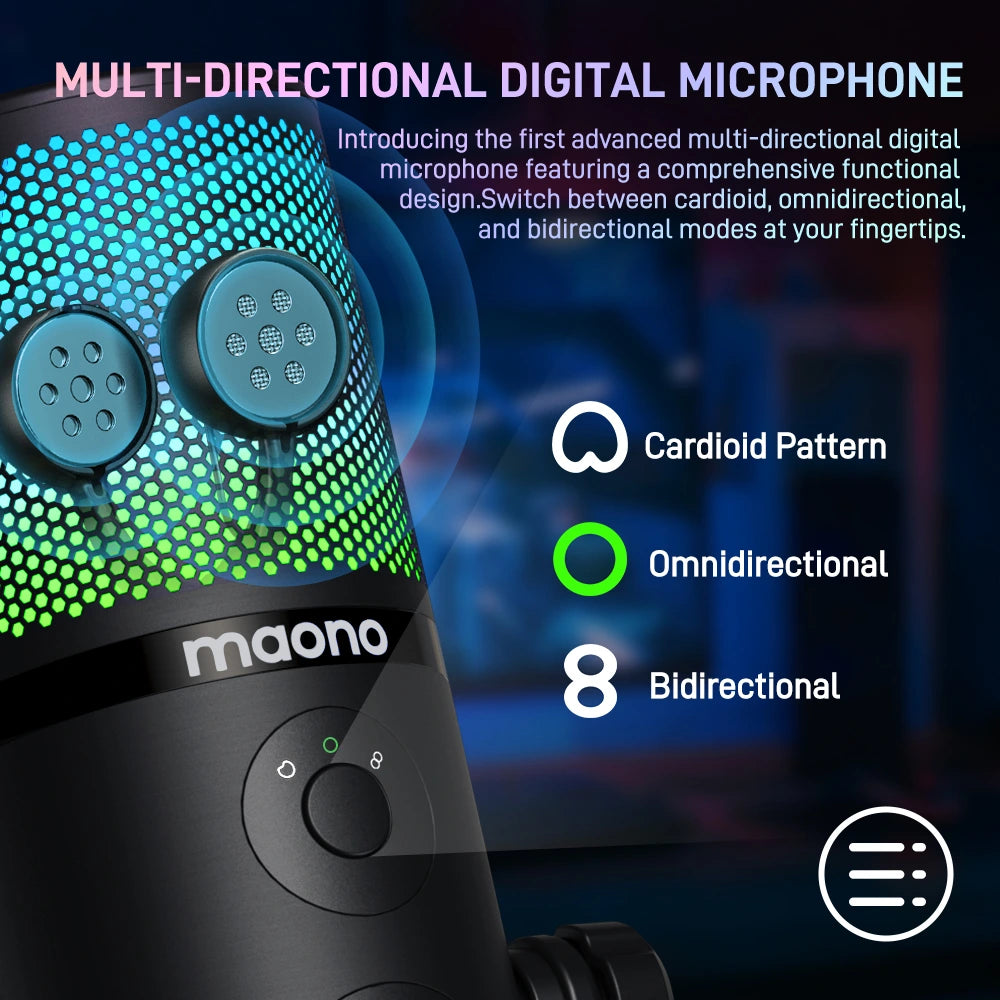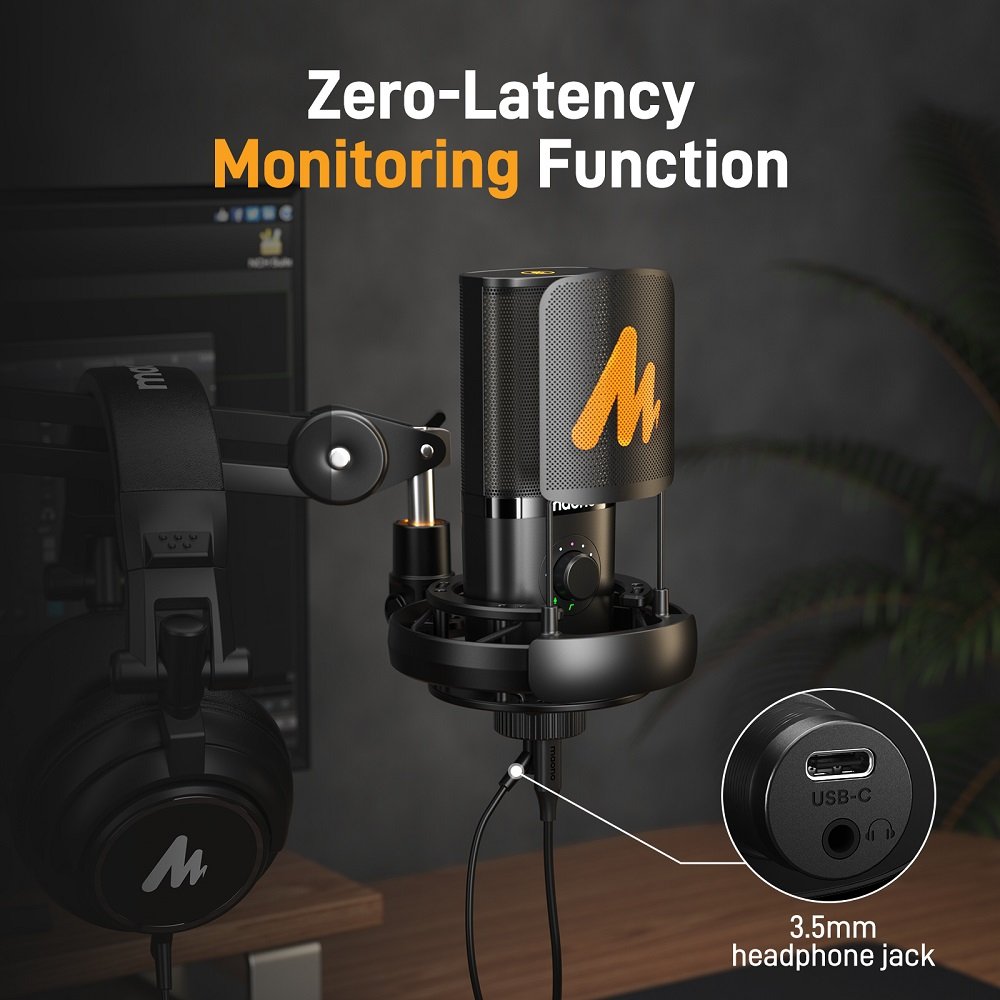Introduction to the Best Microphones for Streaming
As the popularity of live streaming continues to soar, it's becoming increasingly important to invest in the right equipment to enhance the quality of your streams. One crucial element that can make or break your live-streaming experience is the microphone you use. A quality streaming microphone ensures that your voice is crystal clear, allowing your audience to fully engage with your content. In this article, I will guide you through the process of finding the perfect mic and choosing the best mics for streaming in 2024, whether you're a beginner looking to get started or a professional seeking to upgrade your setup.
Why a quality microphone is important for live streaming
When it comes to live streaming, audio quality is just as important as video quality. Whether you're a gamer, a musician, or a content creator, your viewers expect to hear you loud and clear. A poor-quality microphone can result in muffled or distorted sound, causing your audience to lose interest or become frustrated. On the other hand, a decent microphone with high-quality streaming features can transform your live streams into immersive experiences, capturing every nuance of your voice and creating a professional atmosphere.
What qualifies as a 'decent microphone'?
A decent microphone for streaming provides a high-quality and clear audio, easy to use, and offers good value for its price while being durable and reliable in a streaming setup.
In the context of streaming, a decent microphone is one that offers clear, dependable audio quality that is appropriate for live streaming, gaming, or video creation while maintaining an affordable price. The following qualities are essential to a good microphone for streaming:
1. Audio Quality:
Frequency Response: A decent microphone should have a balanced frequency response that covers the full range of human speech, typically between 20Hz and 20kHz.
2. Polar Pattern:
Cardioid Pattern: Most decent microphones for streaming use a cardioid polar pattern, which focuses on capturing sound from the front while minimizing noise from the sides and rear. This helps in reducing background noise and focusing on the streamer’s voice.
3. Connectivity:
USB Connection: For ease of use, a decent microphone should offer USB connectivity, which allows for plug-and-play setup without needing additional equipment like audio interfaces.
Driver Compatibility: The microphone should be compatible with major operating systems (Windows, macOS) without requiring complex driver installations.
4. Build Quality and Durability:
Sturdy Construction: The microphone should be well-built to withstand regular use. A decent microphone should not feel flimsy or prone to damage.
Included Accessories: A decent microphone often comes with accessories like a shock mount, pop filter, and adjustable stand to enhance usability and audio quality.
5. Ease of Use:
User-Friendly Controls: Features like adjustable gain control and a mute button can add convenience and control over audio quality.
Setup and Installation: The microphone should be easy to set up, with straightforward installation procedures and minimal technical hassles.
6. Affordability:
Cost-Effective: A decent microphone should provide good value for its price. It should not be prohibitively expensive but still offer solid performance and features suitable for streaming.
7. Brand and Reviews:
Reputable Brand: Choosing a microphone from a reputable brand with positive user reviews can ensure a reliable and quality product.
User Feedback: The microphone should have favorable reviews from other streamers or content creators, indicating that it performs well in real-world streaming scenarios.
8. Compatibility with other platforms:
Choosing the right microphone means versatility. It's a major plus if the microphone can be used in various platforms like Twitch, YouTube, Discord etc.
Types of streaming microphone
There are several types of streaming microphones available, each with its unique features and advantages. The most common types include dynamic microphones, condenser microphones, and lavalier microphones.
Dynamic microphones are sturdy and versatile, making them ideal for a wide range of applications. They are particularly suitable for streaming in noisy environments, as they have excellent background noise rejection. However, dynamic microphones require you to speak closer to the mic to achieve optimal sound quality.
Condenser microphones, on the other hand, are more sensitive and offer a broader frequency response. They are perfect for capturing vocals and instruments with exceptional clarity. However, they are more susceptible to picking up background noise, so they are better suited for controlled environments.
Lavalier microphones are small, clip-on microphones that are commonly used for interviews and presentations. They provide hands-free operation and are unobtrusive, making them a popular choice for live streaming content creators who are constantly on the move.
Dynamic VS Condenser Microphones: Which Is Best for Gaming and Streaming?
What is a Dynamic Microphone?
Dynamic microphones use the same dynamic principle as speakers, just in reverse. A small movable induction coil located in the magnetic field of a permanent magnet is fixed to the diaphragm. When sound enters through the microphone's windshield, the sound waves move the diaphragm. Dynamic microphones use magnets to convert sound waves into voltage. In a speaker, an electric current causes the diaphragm to vibrate, creating sound waves. Dynamic microphones, on the other hand, use sound waves to vibrate a diaphragm and generate electricity. The power is then added through the use of a transformer and sent to the output of the microphone, creating sound.
What is a Condenser Microphone?
Condenser microphones are designed to pick up high frequencies. To achieve this, the microphone has a capacitor inside its internal structural components. The capacitor consists of two suspended lightweight metal plates, called the diaphragm and the backplate, with a capacitor capsule between them.
Most commonly, condenser microphones are used in recording studios, where their superior frequency transient response and low self-noise are ideal for capturing clean, high-fidelity recordings that are true to the source.
Dynamic microphone VS condenser microphone? Which is best for live streaming & gaming?

Image source: monkey recording house
The biggest difference between these two microphones is their sensitivity. Compared with condenser microphones, dynamic microphones are less sensitive, while condenser microphones are more sensitive. When using dynamic microphones, you need to get closer. To get a richer sound, it is currently recommended that the distance between your mouth and the microphone is about 2-6 inches during use. Then your voice will be more recognizable. During use, you will find that once you get farther away from the microphone, the corresponding sound becomes quieter.
On the contrary, when you use a condenser microphone, you don't need to be very close to your microphone to get a clearer sound. The recommended distance for condenser microphones is between 5-8 inches. You can adjust the stand to determine the best fit. distance. The usability of the condenser microphone will be more inclusive. You don't need to worry or consider whether the distance between the two is too close or too far, as long as you ensure a more comfortable position. The sound of a condenser microphone will be brighter and open.
So, should I choose a condenser mic or a dynamic mic when broadcasting or gaming? it depends, the most important factor is your live broadcast environment, As the condenser microphone is more sensitive and will absorb the surrounding ambient sound. That is, if your live broadcast sound isolation effect is relatively good, there are some settings to absorb ambient sound like bubbles. cotton or wood. Then you can choose a condenser microphone. If the ambient sound in your live broadcast room is relatively loud, it is recommended that you choose a dynamic microphone. This ensures that you will not receive interference from external sounds during live broadcasts or games, and your users can also hear softer sounds.
Disadvantages of dynamic microphones: Not as sensitive as condenser microphones, which means they require the sound source to be close to the microphone to capture clear and accurate sound. There is a lack of high-frequency detail, resulting in a less natural sound with less detail.
Disadvantages of condenser microphone: Higher sensitivity, easy to absorb environmental sound, users can easily hear noise, resulting in less than ideal sound quality.
Features to Look for in the Best Streaming Microphone
Before diving into the world of streaming microphones, it's important to consider a few key factors to ensure you make the right choice for your needs. These factors include your budget, the intended use of the microphone, the environment in which you'll be streaming, and the compatibility with your existing equipment.
Firstly, determine your budget. Streaming microphones come in a wide range of price points, so it's essential to establish how much you're willing to invest. Keep in mind that a higher price tag often correlates with superior sound quality and additional features.
Next, consider the intended use of the microphone. Are you primarily streaming gaming content, or do you also plan to record music or podcasts? Different microphones excel in different applications, so it's crucial to choose one that suits your specific needs.
The environment in which you'll be streaming also plays a significant role in microphone selection. If you frequently stream in noisy environments, a dynamic microphone with excellent background noise rejection would be a wise choice. On the other hand, if you have a quiet and controlled space, a condenser microphone may be the better option for capturing every detail of your voice.
Lastly, ensure that the streaming microphone you choose is compatible with your existing equipment. Check the connectivity options and make sure it can be easily integrated into your setup without requiring additional adapters or converters.
Best Budget Mics for Streaming in 2024
Ⅰ. Best Streaming Microphones for Beginners (Price below $90)
If you're just starting in the world of live streaming, you don't need to break the bank to find a reliable and quality microphone for streaming. Several affordable options offer excellent performance for beginners.
One popular choice among beginners is the Audio-Technica ATR2100x-USB. This dynamic microphone provides clear and crisp audio, while its USB connectivity allows for easy plug-and-play operation.
Why Ideal for Streaming in 2024: The ATR2100x-USB offers flexibility with both USB and XLR outputs, making it perfect for streamers who may want to upgrade their setup over time.
Sound Quality: It provides a cardioid polar pattern, ensuring clear voice capture while minimizing background noise.
Ease of Use: Plug-and-play with USB, simple setup, and built-in headphone jack for monitoring.
Compatibility: Works seamlessly with all major streaming platforms like Twitch, YouTube, and Discord
For those on a tight budget, the Maono USB microphone is a fantastic entry-level option. For live streaming. Despite its affordable price, it delivers surprisingly good sound quality and comes with a sturdy desktop stand.
DM30RGB would be the best USB streaming microphone for its budget price. This is a plug-and-play USB condenser microphone specially designed for streaming and gaming. Its built-in one-button mute and controllable RGB effect functions are more popular among most game users. It has excellent off-axis noise suppression performance. 4 kinds of equalization mode adjustment, highlight the human voice and deliver a smooth and clear voice, enjoy a more immersive game live streaming experience. Especially paired with the B01 microphone stand would save you a lot while getting a better sound output.
Why Ideal for Streaming in 2024: Combines high-quality audio with customizable RGB lighting, appealing to gamers and streamers focused on aesthetics.
Sound Quality: Delivers clear and crisp audio with a cardioid pattern that captures vocals effectively.
Ease of Use: USB connectivity ensures easy setup, with customizable RGB lighting adding a personal touch.
Compatibility: Compatible with PC and Mac, integrates smoothly with popular streaming platforms

DM30RGB: An award-winning, decent microphone for gaming
Ⅱ. Mid Range Streaming Microphones for Intermediate Users (Price Between $99-$249)
If you've been live streaming for a while and are ready to take your setup to the next level, it may be time to upgrade to a mid-range streaming microphone. These microphones offer improved audio quality and additional features to enhance your live-streaming experience.
The Audio-Technica AT2020 is a popular choice in the mid-range category. This condenser microphone delivers studio-quality sound and features a cardioid polar pattern for excellent noise isolation. Another excellent option is the Rode NT1, known for its low self-noise and crystal-clear audio reproduction.
Why Ideal for Streaming in 2024: Known for its affordability and high-quality sound, the AT2020 is a staple for streamers and content creators.
Sound Quality: Offers a wide frequency response and low self-noise, capturing detailed and natural sound.
Ease of Use: Requires an audio interface, making it slightly more complex but worth it for advanced setups.
Compatibility: Works well with XLR interfaces and is highly compatible with streaming software like OBS and Streamlabs
If you are using it for game live streaming, then Maono’s PD200XS stand microphone will be one of the top streaming microphones selected. It is the white classic model that most users love most. What’s even more valuable is that it is a USB & XLR dynamic microphone. The dual-mode design allows you to change the microphone at any time according to your usage scenario.

If you don’t like the built-in stand, you can choose the BA91 360° adjustable stand, which is also a good choice. This is the microphone that was born for you to enjoy a personalized livestream atmosphere with your fans there. most of Maono's friends use it streaming on Twitch, YouTube, TikTok, or Facebook.
If you have relatively high requirements for sound quality, then Maono's other dual-mode dynamic microphone PD400X is also a good dynamic microphone for streaming. The characteristic of this microphone is that its sound quality is the best, Compared with Shure SM7B, the price is very friendly for most users while ensuring the quality of the sound. 45% of users from SOUNDCLOUD and BUZZSPROUT chose it for podcasts. 40% of YOUTUBE choose it for high-quality video and live streaming with the bundle.
Why Ideal for Streaming in 2024: Combines high-end sound quality with rugged durability, perfect for professional streamers.
Sound Quality: Features a dynamic capsule that delivers rich, warm sound, ideal for voice.
Ease of Use: USB and XLR outputs offer versatility for both beginners and pros.
Compatibility: Seamless integration with popular streaming software and hardware
Ⅲ. Top of the Line Streaming Microphones for Professionals (Price Up to $300)
For professional live streamers and content creators who demand the absolute best in audio quality, top-of-the-line streaming microphones are the way to go. These microphones deliver unparalleled performance and are often used in professional studios and broadcasting environments.
If you prefer a dynamic microphone, the Shure SM7B is a good choice. It offers a smooth and warm sound, making it a favorite among broadcasters and podcasters. Additionally, it features built-in controls to tailor the sound to your liking.
Why Ideal for Streaming in 2024: The SM7B is a legendary microphone known for its professional broadcast quality, making it a top choice for serious streamers.
Sound Quality: Offers a flat, wide-range frequency response for exceptionally clean and natural reproduction of both music and speech.
Ease of Use: Requires a preamp due to its low output, making it more suitable for advanced users.
Compatibility: Works with all professional audio interfaces and streaming setups
Another top-of-the-line option is the Sennheiser MKH 416. This shotgun microphone excels at capturing vocals with incredible detail and rejecting unwanted background noise. It is widely used in film and television production and is a favorite among professional voice actors and streamers.
Why Ideal for Streaming in 2024: A high-end shotgun microphone, ideal for streamers who need a focused sound in untreated environments.
Sound Quality: Delivers precise and rich sound, with a super-cardioid pattern that reduces off-axis noise.
Ease of Use: XLR connection requires a professional setup, ideal for streamers with advanced audio needs.
Compatibility: Compatible with high-end audio interfaces and works well with DAWs and streaming software
Honorable Mentions:
Here is a list of comparisons and noteworthy points to mention when talking about the best decent microphones for streaming
1. Shure MV7
The Shure MV7 is a dynamic microphone with both USB and XLR connectivity, making it versatile for various setups. Inspired by the legendary SM7B, it offers high-quality audio for streamers, podcasters, and musicians.
Reasons to Buy:
✅ Dual USB/XLR output
✅ Excellent sound quality
✅ Built-in touch panel for volume and mute controls
✅ Voice isolation technology
Reasons to Avoid
❌ Higher price point compared to some other USB mics
❌ Requires some setup for optimal use
Pros
✅ Versatility with USB and XLR options
✅ Rich and clear audio quality
✅ Easy-to-use touch controls
✅ Durable build
Cons
❌ Learning curve for beginners
❌ More expensive than entry-level mics
Notable Features
✅ USB and XLR connectivity
✅ Voice isolation technology
✅ Touch panel controls for gain, monitoring, and mute
✅ ShurePlus MOTIV app for additional audio customization
Why Ideal for Streaming in 2024: Offers both USB and XLR outputs, making it versatile for streamers at all levels.
Sound Quality: Dynamic capsule tailored for voice capture, providing a warm and focused sound.
Ease of Use: USB connectivity offers a plug-and-play experience, with advanced features available through the ShurePlus MOTIV app.
Compatibility: Integrates well with all major streaming platforms and software
2. Razer Seiren Mini
The Razer Seiren Mini is a compact and affordable condenser microphone designed for streamers who need a portable and high-quality audio solution.
Reasons to Buy
✅ Compact and portable
✅ Affordable price
✅ Good sound quality for its size
Reasons to Avoid
❌ Lacks advanced features
❌ Limited to USB connection
Pros
✅ Affordable
✅ Easy to set up
✅ Clear audio quality
✅ Small footprint
Cons
❌ No onboard controls
❌ No headphone monitoring
Notable Features
✅ Ultra-compact design
✅ Supercardioid pickup pattern for focused audio capture
✅ Built-in shock mount
Why Ideal for Streaming in 2024: Compact and budget-friendly, ideal for beginners or those with limited desk space.
Sound Quality: Supercardioid pattern ensures focused voice capture with minimal background noise.
Ease of Use: USB plug-and-play, extremely easy to set up and use.
Compatibility: Compatible with PC and Mac, perfect for entry-level streaming on platforms like Twitch and YouTube
3. HyperX QuadCast S
The HyperX QuadCast S is a USB condenser microphone with customizable RGB lighting, ideal for streamers who want both excellent audio and visual appeal.
Reasons to Buy
✅ Customizable RGB lighting
✅ Excellent sound quality
✅ Multiple polar patterns
✅ Built-in anti-vibration shock mount
Reasons to Avoid
❌ Slightly bulkier design
❌ Higher price for those on a budget
Pros
✅ Great sound quality
✅ Versatile with multiple polar patterns
✅ Eye-catching RGB lighting
✅ Built-in pop filter
Cons
❌ Larger footprint
❌ USB only
Notable Features
4. SteelSeries Alias Pro
The SteelSeries Alias Pro is a high-end microphone designed for professional streamers, featuring advanced audio technology and a sleek design.
Reasons to Buy
✅ High-end audio quality
✅ Advanced noise-canceling features
✅ Durable and stylish design
Reasons to Avoid
❌ Premium price
❌ Complex setup for beginners
Pros
✅ Professional-grade audio
✅ Noise-canceling technology
✅ Durable build
Cons
❌ Expensive
❌ Requires some technical knowledge for optimal use
Notable Features
✅ Advanced noise-canceling technology
✅ Professional-grade sound quality
✅ Stylish and durable design
Why Ideal for Streaming in 2024: A premium option designed specifically for streamers, offering superior sound quality and integration with streaming software.
Sound Quality: Delivers clear, broadcast-quality sound with a focus on voice clarity.
Ease of Use: USB connectivity with intuitive controls and integration with SteelSeries GG software for easy customization.
Compatibility: Works seamlessly with major streaming platforms and software, designed with streamers in mind
5. Blue Snowball Ice
The Blue Snowball Ice is a budget-friendly USB microphone known for its simplicity and reliable audio quality, making it a popular choice among beginner streamers.
Reasons to Buy
✅ Affordable price
✅ Easy to use
✅ Reliable sound quality
Reasons to Avoid
❌ Limited features
❌ No headphone jack
Pros
✅ Budget-friendly
✅ Plug-and-play setup
✅ Clear audio quality
Cons
❌ Limited controls and features
❌ No built-in monitoring
Notable Features
✅ Cardioid pickup pattern
✅ Simple plug-and-play USB connection
✅ Durable build
Why Ideal for Streaming in 2024: An affordable and reliable choice for entry-level streamers looking for a no-fuss microphone.
Sound Quality: Offers clear audio quality with a cardioid pattern, perfect for solo streaming.
Ease of Use: Simple plug-and-play USB connection, making it ideal for beginners.
Compatibility: Compatible with both PC and Mac, easily integrates with streaming software
6. Elgato Wave: 3
The Elgato Wave: 3 is a premium USB condenser microphone tailored for streamers, featuring a clipguard technology to prevent audio distortion.
Reasons to Buy
✅ High-quality audio
✅ Clipguard technology
✅ Integrated digital mixer
Reasons to Avoid
❌ Higher price point
❌ Limited to USB connection
Pros
✅ Excellent sound quality
✅ Clipguard technology prevents distortion
✅ Integrated digital mixer for audio control
Cons
❌ Pricey for a USB mic
❌ No XLR option
Notable Features
✅ Clipguard technology
✅ Integrated digital mixer
✅ High-resolution audio capture
Why Ideal for Streaming in 2024: Combines high-quality audio with Elgato’s streaming ecosystem, making it a top choice for streamers.
Sound Quality: Delivers crystal-clear audio with a condenser capsule and Clipguard technology to prevent distortion.
Ease of Use: USB-C connection with integrated Wave Link software for mixing and controlling audio channels.
Compatibility: Fully compatible with Elgato Stream Deck, OBS, and other streaming platforms
7. Razer Seiren X
The Razer Seiren X is a compact condenser microphone designed for streamers, offering a good balance of quality and portability.
Reasons to Buy
✅ Compact and portable
✅ Good audio quality
✅ Affordable
Reasons to Avoid
❌ Limited features
❌ No advanced controls
Pros
✅ Portable design
✅ Decent sound quality
✅ Affordable price
Cons
❌ Limited functionality
❌No headphone monitoring
Notable Features
✅ Supercardioid pickup pattern
✅ Built-in shock mount
✅ Compact form factor
Why Ideal for Streaming in 2024: A compact and sleek microphone designed specifically for gamers and streamers.
Sound Quality: Supercardioid pickup pattern minimizes ambient noise, providing focused voice capture.
Ease of Use: USB connection with a simple plug-and-play setup, ideal for those looking for hassle-free streaming.
Compatibility: Works with PC, Mac, and major streaming platforms, ideal for gaming streams
8. Blue Yeti X
The Blue Yeti X is a top-tier USB condenser microphone with multiple polar patterns, customizable LED lighting, and advanced audio controls.
Reasons to Buy
✅ High-quality sound
✅ Multiple polar patterns
✅ Customizable LED lighting
Reasons to Avoid
❌ Bulky design
❌ Higher price
Pros
✅ Excellent audio quality
✅ Versatile polar pattern options
✅ Built-in audio controls
Cons
❌ Large size
❌ Expensive
Notable Features
✅ Four polar pattern options (cardioid, bidirectional, omnidirectional, stereo)
✅ Customizable LED metering
✅ Blue VO!CE software for audio effects
Why Ideal for Streaming in 2024: Offers advanced features and high-quality audio, making it a popular choice for streamers.
Sound Quality: Features a four-capsule array that delivers clear and powerful sound with four polar patterns.
Ease of Use: USB connectivity with easy-access controls and customizable LED metering.
Compatibility: Compatible with PC and Mac, works with Blue VO!CE software for audio customization
9. PD400XS
The Maono PD400XS is a dynamic microphone designed for content creators, podcasters, and streamers. It features both USB and XLR outputs, allowing users to connect to a variety of devices, from computers to professional audio interfaces. With a robust metal construction and a sleek design, the PD400XS is built for durability and professional use. It also includes a built-in pop filter and a shock mount to minimize noise and vibrations during recording.
Reasons to Buy
✅ Versatile Connectivity: The dual USB/XLR outputs make it suitable for both beginner and professional setups
✅ Built-In Features: Includes a pop filter and shock mount, reducing the need for additional accessories.
✅ Durability: Solid metal build ensures longevity and reliability
✅ Sound Quality: Delivers broadcast-quality sound with minimal background noise
Reasons to Avoid
❌ Slightly higher price
Pros
✅ Great sound quality with minimal background noise
✅ Dual USB/XLR outputs
✅ Durable metal construction
Cons
❌ Larger size
❌ Slightly more expensive than other Maono USB/XLR mics
Notable Features
✅ Built-In Pop Filter: Reduces plosive sounds without needing an external filter
✅ Dual Connectivity: USB and XLR outputs for flexible use
✅ Zero-Latency Monitoring: Ensures real-time audio feedback without delay
✅ Professional Design: Sturdy and stylish metal build
Why Ideal for Streaming in 2024: Offers high-quality sound output, dual connectivity options, and built-in features that simplify the streaming setup. Its ability to deliver broadcast-quality audio with minimal background noise makes it a strong contender for any streaming setup, whether you're a beginner or a professional.
Sound Quality: features excellent sound quality, with a focus on clear, rich audio that captures voice details while minimizing background noise. The dynamic capsule is designed to pick up sound directly in front of the microphone, reducing unwanted ambient noise, which is crucial for live streaming and podcasting.
Ease of Use: The microphone is user-friendly, with simple plug-and-play USB connectivity for beginners and more advanced XLR output for professional setups. The inclusion of built-in features like a pop filter and shock mount makes it easy to set up and start recording without needing additional equipment.
Compatibility with Streaming Platforms: The Maono PD400XS is compatible with all major streaming platforms, including Twitch, YouTube, and Discord. The USB output ensures that it can easily connect to computers and be recognized by streaming software, while the XLR output offers compatibility with more advanced audio interfaces and mixers. This versatility makes it an excellent choice for streamers looking for flexibility in their audio setup.
10. PreSonus PD-70
The PreSonus PD-70 is a dynamic broadcast microphone designed for professional streaming and podcasting, offering robust sound quality and excellent background noise rejection.
Reasons to Buy
✅ Professional-grade audio quality
✅ Excellent noise rejection
✅ Durable build
Reasons to Avoid
❌ Requires audio interface
❌ No USB connectivity
Pros
✅ Broadcast-quality sound
✅ Superior noise isolation
✅ Sturdy construction
Cons
❌ Needs an audio interface
❌ No USB option
Notable Features
✅ Dynamic cardioid pattern
✅ Broadcast-quality sound
✅ Rugged build for professional use
Why Ideal for Streaming in 2024: A dynamic broadcast microphone designed for professional-quality streaming and podcasting.
Sound Quality: Offers a smooth and clear sound, with a cardioid pattern that reduces background noise.
Ease of Use: XLR connection requires an audio interface, making it suitable for more advanced setups.
Compatibility: Works well with professional audio interfaces and all major streaming platforms
11. Samson Go
The Samson Go is an ultra-portable USB condenser microphone perfect for streamers on the go, offering good sound quality in a compact and foldable design.
Reasons to Buy
✅ Extremely portable
✅ Affordable
✅ Decent sound quality for its size
Reasons to Avoid
❌ Limited features
❌ No advanced controls
Pros
✅ Ultra-portable
✅ Affordable
Foldable design
Cons
❌ Basic functionality
❌ No headphone jack
Notable Features
✅ Compact and foldable design
✅ Cardioid and omnidirectional pickup patterns
✅ USB plug-and-play connectivity
Why Ideal for Streaming in 2024: Portable and compact, making it a great option for streamers who travel or have limited space.
Sound Quality: Offers decent sound quality for its size, with a cardioid pattern that focuses on the speaker's voice.
Ease of Use: USB plug-and-play, extremely easy to set up and use on the go.
Compatibility: Works with PC, Mac, and major streaming platforms, ideal for mobile or quick setup streaming
Table Summary: Best Streaming Microphones of 2024: Top Picks

Additional equipment and accessories for streaming microphones
To maximize the performance of your streaming microphone, there are a few additional equipment and accessories you may want to consider investing in. A good pop filter helps eliminate plosive sounds caused by strong puffs of air hitting the microphone, resulting in a cleaner and more professional sound.
A microphone stand or boom arm is also essential for positioning the microphone at the optimal distance and angle. This ensures that you achieve the best sound quality and minimizes handling noise.
If you want to know which microphone stand is best for you, you can read this article to get some suggestions: Everything You Need to Know About the Microphone Stand
If you plan to move around while streaming, a shock mount can help reduce unwanted vibrations and handling noise. This is particularly useful for condenser microphones, which are more sensitive to such disturbances.
Lastly, a quality audio interface or mixer may be necessary to connect your streaming microphone to your computer or other devices. These devices provide additional control over your audio levels and can improve the overall sound quality of your live streams.
Tips for using and maintaining your streaming microphone
Once you've found the perfect streaming microphone for your needs, it's important to know how to use and maintain it properly. Here are a few tips to help you get the most out of your microphone:
Position the microphone correctly: Experiment with microphone placement to find the optimal distance and angle for your voice. Generally, positioning the microphone 6-12 inches away and slightly off-axis from your mouth produces the best results.
Use a windscreen or pop filter: These accessories help minimize plosive sounds and protect the microphone from moisture and debris. Regularly clean and replace them to ensure optimal performance.
Avoid excessive handling: Handling the microphone unnecessarily can introduce unwanted noise and vibrations. Minimize handling as much as possible to maintain a clean and professional sound.
Store the microphone properly: When not in use, keep your streaming microphone in a safe and dust-free environment. Use a protective case or pouch to prevent damage during transportation.
Perform regular maintenance: Clean the microphone and its accessories regularly using a soft, lint-free cloth. Avoid using harsh chemicals or abrasive materials that could damage the microphone's finish.
Streaming Microphone FAQs :
What is the best microphone for streaming on a budget?
For budget-conscious streamers, the Blue Yeti and Fifine K669B are excellent choices.
Blue Yeti: This USB microphone is renowned for its high-quality sound at an affordable price. It offers multiple polar patterns (cardioid, bidirectional, omnidirectional, and stereo), which provides versatility for different streaming setups. Its plug-and-play functionality makes it easy to use without needing additional equipment.
Fifine K669B: Another budget-friendly option, this USB microphone delivers good audio quality with minimal background noise. It has a cardioid pickup pattern, which helps focus on the speaker’s voice while rejecting unwanted ambient noise. It is a great choice for streamers who want a reliable microphone without breaking the bank.
Maono DM30RGB: is a game changer, this USB condenser microphone is aesthetic and reproduces high-quality sound, which is reliable for streaming.
These options provide excellent sound quality for their price range and are popular among streamers for their affordability and ease of use.
What’s the best microphone for streaming on Twitch?
The best microphone for streaming on Twitch depends on your needs and budget, but two excellent options are the Maono PD400X and Maono DM30RGB. The PD400X is a versatile dynamic mic with both USB and XLR connectivity, offering clear sound and superb noise cancellation, making it great for streamers in noisy environments. The DM30RGB is a more budget-friendly option, providing high-quality sound with a stylish RGB design, perfect for gamers and streamers who want a professional mic without breaking the bank. Both mics deliver excellent performance for Twitch streaming.
How important is microphone quality for live streaming?
Microphone quality is crucial for live streaming because it directly impacts how clearly and professionally your audio is perceived by your audience. High-quality audio ensures that your voice is clear, engaging, and free from distortion or background noise, which can significantly enhance the viewer's experience.
Clarity: A good microphone captures your voice with clarity, making it easier for viewers to understand and engage with your content.
Professionalism: High-quality audio contributes to a more polished and professional presentation, which can help build your brand and audience trust.
Engagement: Clear and high-fidelity sound keeps viewers engaged and reduces the likelihood of them tuning out due to poor audio quality.
Investing in a good microphone is essential for maintaining a professional streaming setup and providing a high-quality experience for your viewers.
What type of microphone is best for gaming and streaming?
For gaming and streaming, condenser microphones and dynamic microphones are popular choices, each offering distinct advantages depending on your needs:
Condenser Microphones: These are often favored for their sensitivity and detailed sound reproduction. Models like the Blue Yeti or Maono DM30RGB are popular choices, especially for beginners who are very particular in spending wisely. Condenser mics are excellent for capturing clear and precise vocal tones, making them ideal for streamers who want to ensure their voice is heard clearly and with high fidelity. They are particularly well-suited for controlled environments where background noise can be managed.
Dynamic Microphones: If you’re streaming in a noisy environment or want a microphone that rejects background noise effectively, a dynamic microphone like the Shure SM7B is a great choice. Alternatively, the Maono PD400X is a must-have if you want your audio to sound clear, crisp, and just professional, plus, it's affordable given its price point. Dynamic mics are less sensitive to ambient noise and are more focused on capturing sound from the front of the microphone. This makes them ideal for noisy or less controlled streaming setups.
Both types of microphones can be excellent for gaming and streaming, depending on your specific needs and environment. Condenser microphones are great for capturing detailed audio in quieter settings, while dynamic microphones excel in environments with more background noise.
Should I use a USB or XLR mic for streaming?
The best thing about USB microphones is that they are plug-and-play. You can plug the microphone directly into your computer just like you would a mouse, keyboard, or any other USB device. This is a super simple and worry-free option for streamers and gamers looking to upgrade their audio. In addition, generally, USB microphones can be connected to headphones so that you can communicate with your teammates during game live broadcasts. Therefore, a USB microphone is a relatively suitable microphone choice for gaming and live streaming.
Arguably, USB microphones are better suited for beginners or streamers who want to keep their setup economical and simple. Just plug in your PC or Mac and start recording; XLR microphones are more professional and can provide excellent audio quality. They are also a good investment and can be used directly when you need more professional equipment in the future, such as an audio interface (or audio mixer), etc., due to the connection requirements of these devices. You have the corresponding XLR connector to make it work.
How do streamers make their mic sound so good?
First of all, you will have to select a microphone with a better sound quality, then you can try optimizing your equalizer, expander, noise suppression, and compressor levels can make your voice stand out—while staying uniquely yours. If you have a low-quality microphone and don't use audio mixing tools, you may find that your streaming audio sounds flat, monotonous, muffled, and has inconsistent volume levels.
Do I need to buy an extra audio mixer for live streaming?
An audio mixer takes multiple audio sources and mixes, balances, and combines them into a single signal. If you regularly use multiple microphones, stream music, or broadcast video games, you'll have to use a mixer to fine-tune the sound to give your fans a better experience. but you can try to buy a dual-mode microphone like PD200X first, as it has XLR and USB mode, allowing you to change easily. there comes the AMC2 NEO streaming mixer would fix all your needs while live streaming. both the microphone and audio mixer are the perfect match for most gamers and live streamers.

How to make My voice sound smoother when streaming?
1. Adjust the distance between your microphone and your mouth to an appropriate distance. most of the time the closer, the better it should be.
2. Reduce reverberation.
3. Make your speaker face the microphone, the better the sound quality.
4. Serve your room a better sound insulation effect and reduce the absorption of noise.
5. In addition, the quality of the live broadcast equipment you choose needs to be up to the standard, otherwise the overall user sound experience will be reduced.
6. Check all the setups before going live.
What is a polar pattern and which one do I need for gaming?
A polar pattern describes how a microphone picks up sound from different directions. For gaming, a cardioid polar pattern is typically preferred as it focuses on sound directly in front of the mic, reducing background noise; bidirectional picks up from front and back, omnidirectional from all around, and stereo captures left and right audio for more immersive soundscapes.
What are the other factors to consider when choosing a decent microphone?
Microphone sensitivity and versatility are critical factors when choosing a microphone. Sensitivity ensures you can capture the desired sound quality based on your environment, while versatility allows the microphone to adapt to different recording needs and devices. Together, they determine how effectively a microphone will perform in various scenarios, making them essential considerations for any user.
What is an example of a good bit rate for a microphone?
A sample rate of 48kHz is standard for many microphones, and you shouldn't go lower than that for good quality. For bit depth, 16-bit or higher is considered good.
How much should I spend on a mic for streaming?
Microphone prices can range from $50 to over $500, but it's important to buy the best quality microphone you can afford to ensure it works well and lasts a long time.
What is the best microphone for streaming on YouTube?
YouTubers frequently utilize the Shure MV7 or the Audio-Technica AT2020+ as their microphone of choice. Their exceptional sound quality, adaptability, and dependable operation have made them both well-liked. Also, Maono's DM30RGB, PD200XS, and PD400XS are continuously the best selling microphone in the market due to its high-quality, professional audio, affordability, and versatility.
How do I connect my mic to my streaming device?
The majority of microphones are USB-connected. The setup is simple and involves just plugging in the device to start streaming. On the other hand, some microphones might need extra hardware, such an audio interface. Finding the best connectivity product always requires reading the manufacturer's instructions and suggestions.
Conclusion and Final Thoughts
Selecting the best microphones for streaming is a crucial step in creating high-quality live streams that captivate and engage your audience. Consider your budget, intended use, environment, and compatibility when making your decision. Whether you're a beginner, an intermediate user, or a professional, there is a decent microphone out there that will meet your needs and elevate your live streaming experience. With the right microphone and a few additional accessories, you'll be well on your way to delivering exceptional audio quality and making a lasting impression on your viewers. Select the best streaming microphone in 2024, and take your pick Maono's collections of high quality microphones, and ensure you invest in a quality streaming microphone today to take your live streams from beginner to pro.
Also Read:
Headset vs USB Gaming Microphone: Which is the Best Mic for Live Performance?










